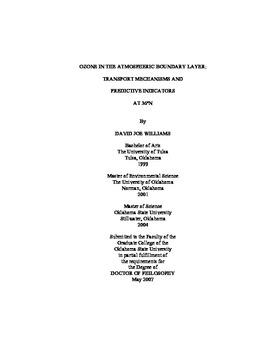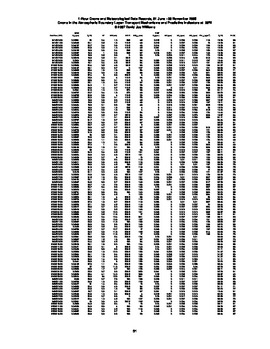Ozone in the Atmospheric Boundary Layer: Transport Mechanisms and Predictive Indicators at 36ºN
Ozone in the atmospheric boundary layer: Transport mechanisms and predictive indicators at 36�N
| dc.contributor.advisor | Sanders, Dee Ann | |
| dc.contributor.author | Williams, David Joe | |
| dc.date.accessioned | 2013-12-10T18:05:35Z | |
| dc.date.available | 2013-12-10T18:05:35Z | |
| dc.date.issued | 2007-05 | |
| dc.identifier.uri | https://hdl.handle.net/11244/7840 | |
| dc.description.abstract | Scope and Method of Study: The objectives of this study were the estimation of the background ozone concentration specific to the study location, correlation between the background concentration and ground-level ozone, evaluation of the relationship between meteorological parameters and ozone (measured as the background concentration and at ground level), and identification of transport pathways for the component of local ozone concentrations not explained by local photochemistry. Ozone was measured in 1-hour averages at an elevation of 210 meters above ground level, with a companion set of control data measured in 1-hour averages at ground level. Data collection occurred in Tulsa, Oklahoma, a mid-sized city located at a latitude of 36ºN, over the period beginning on 01 June 2005 and ending on 30 November 2005. Additionally, meteorological data were collected at the 210-meter ozone installation and were retrieved from National Oceanic and Atmospheric Administration sites that measure and record ground-level conditions, upper-air soundings, and vertical wind profiles. Solar radiation data was retrieved from the Oklahoma Mesonet. | |
| dc.description.abstract | Findings and Conclusions: Local meteorological conditions were found to be more important to local photochemical generation of ozone than to the behavior of the 210-meter concentration, representative of background ozone in the troposphere. Specifically, a negative correlation with an R2 of 0.5286 was achieved between ground-level ozone and relative humidity, while a positive correlation with an R2 of 0.4897 was achieved between ground-level ozone and dry-bulb temperature. All ground-level ozone concentrations ≥ 0.08 ppm occurred at dry-bulb temperatures ≥ 27ºC and relative humidity ≤ 50%. Solar radiation was of marked importance to ground-level concentrations as well, as R2 equaled 0.6065. Wind speed had a lower correlation with ground-level ozone (R2 = 0.1121), but all occurrences of ground-level ozone ≥ 0.08 ppm during the study were accompanied by ground-level wind speeds < 5 m·s^-1. When compared with 210-meter ozone, local meteorological conditions showed poor or no correlation. Instead, the 210-meter concentration was found to be correlated with geopotential heights at 300 hPa, representative of the height of the polar jet stream. This correlation improved as heights in close proximity to the mean position of the polar jet were considered, with a maximum R2 of 0.38 when 210-meter ozone was compared with 300 hPa geopotential heights at 46ºN. Furthermore, the best correlation was achieved with an 18-hour lag between 210-meter ozone and 300 hPa geopotential heights, accounting for the vertically-tilted structure of atmospheric waves. From the correlation between 210-meter ozone and 300 hPa geopotential heights, it can be concluded that atmospheric disturbances, both as Rossby and baroclinic waves, strongly influence the tropospheric background ozone concentration, as high concentrations were favored during large-scale anti-cyclonic subsidence, while low concentrations were favored during large-scale cyclonic lift. These processes ultimately affected ground-level ozone, as a strong correlation was shown with 210-meter ozone (R2 = 0.8781) during the afternoon hours. Horizontal ozone transport was shown to be appreciable at a distance of 80 km, but based on dispersion modeling, transport at a horizontal distance of 400 km did not appear to contribute significantly to ground-level concentrations. | |
| dc.format | application/pdf | |
| dc.language | en_US | |
| dc.rights | Copyright is held by the author who has granted the Oklahoma State University Library the non-exclusive right to share this material in its institutional repository. Contact Digital Library Services at lib-dls@okstate.edu or 405-744-9161 for the permission policy on the use, reproduction or distribution of this material. | |
| dc.title | Ozone in the Atmospheric Boundary Layer: Transport Mechanisms and Predictive Indicators at 36ºN | |
| dc.title | Ozone in the atmospheric boundary layer: Transport mechanisms and predictive indicators at 36�N | |
| dc.contributor.committeeMember | Carlson, J. D. | |
| dc.contributor.committeeMember | Clarkson, William | |
| dc.contributor.committeeMember | Wilber, Greg | |
| osu.filename | Williams_okstate_0664D_2321.pdf | |
| osu.accesstype | Open Access | |
| dc.type.genre | Dissertation | |
| dc.type.genre | Numeric data | |
| dc.type.material | Text | |
| dc.type.material | Dataset | |
| dc.subject.keywords | ozone | |
| dc.subject.keywords | transport | |
| dc.subject.keywords | troposphere | |
| dc.subject.keywords | meteorology | |
| dc.subject.keywords | subsidence | |
| dc.subject.keywords | wave | |
| thesis.degree.discipline | Civil Engineering | |
| thesis.degree.grantor | Oklahoma State University |
Files in this item
This item appears in the following Collection(s)
-
OSU Dissertations [11222]

